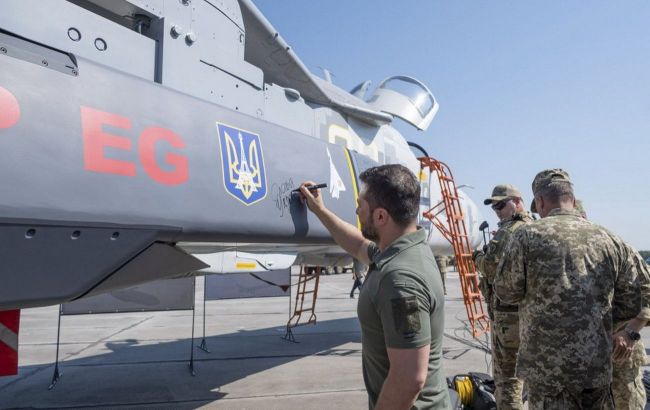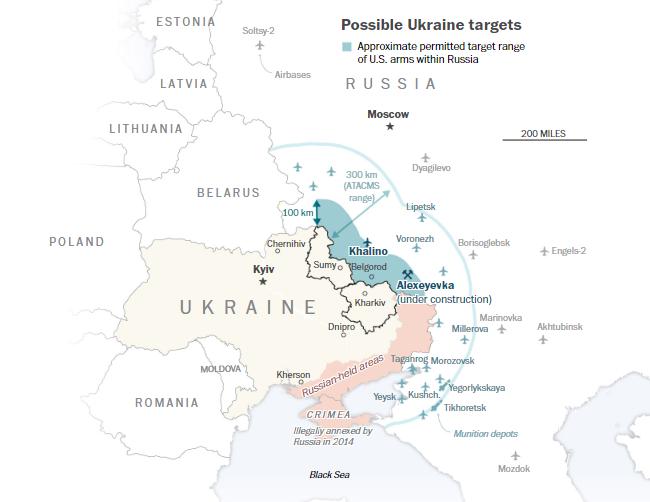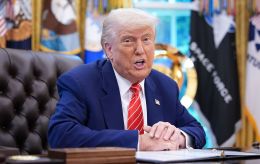Success story? Will Kursk breakthrough accelerate Western approval for strikes deeper into Russia
 Photo: President Volodymyr Zelenskyy signs a Storm Shadow/Scalp missile under the wing of a Su-24 (president.gov.ua)
Photo: President Volodymyr Zelenskyy signs a Storm Shadow/Scalp missile under the wing of a Su-24 (president.gov.ua)
The operation by the Armed Forces of Ukraine in the Kursk region has made the issue of long-range strikes on Russian territory particularly relevant. This is not only to establish a lasting presence but also to weaken the enemy's combat potential, for example, by attacking military airfields.
The RBC-Ukraine report covers which partners are providing long-range weapons, the existing restrictions, and whether allies will lift the taboo on strikes deeper into Russia.
Contents
- How the Kursk Breakthrough revitalized the topic of strikes deeper into Russia
- How the West eased restrictions on using its weapons
- Who among the allies is providing Ukraine with long-range weapons
- Will successes in the Kursk region accelerate the approval for ATACMS and Storm Shadow strikes
How the Kursk Breakthrough revitalized the topic of strikes deeper into Russia
The offensive in the Kursk region began on August 6, 2024. However, Ukraine officially confirmed the breakthrough a week later. The interim result is that the Armed Forces control about 1,000 square kilometers of enemy territory and over 70 settlements.
The main combat actions are concentrated in the Suzhda and Korenevo districts. On one front, the Defense Forces reached the Snagost line and took control of part of the bypass road from Sudzha to Rylsk. On another front towards Lgov, they approached the line from Kauchuk to Anastasievka; on a third, along the R200 road, they established control over Sudzha and reached the Russian Poriechnoye - Martynovka line; and on a fourth, they reached Plekhovo and Borki.
In recent days, the battle zone seems to have expanded into the neighboring Belovsky and Krasnoyaruzhsky districts. However, the pace of advancement has somewhat slowed. This is not so much due to Russian reinforcements but because of the distance from Ukrainian rear lines. Clearly, under these conditions, further success will also depend on Ukraine’s long-range capabilities.

Photo: Map of the battles in the Kursk region (understandingwar.org)
Ahead of this, President Volodymyr Zelenskyy had stated that long-range strikes would bring the war closer to a just conclusion. He instructed Defense Minister Rustem Umerov and diplomats to prepare a plan for the next Strategic Command meeting on how to obtain approval from partners for the use of long-range weapons.
In July, Zelenskyy stated that if allies want Ukraine to win, they must lift all restrictions, including those on strikes against airfields housing frontline bombers.
As RBC-Ukraine reported, one option for combating enemy carriers of KABs (guided aerial bombs-ed.) that destroy Ukrainian positions is to destroy the Su-24 bombers on the ground. This would require attacking airfields such as Morozovsk (the Rostov region), Baltimor (the Voronezh region), Sescha (the Bryansk region), and Shaikovka (the Kaluga region). The problem is that these are 150 to 300 km away, and partners have yet to give the green light for long-range strikes.
Strikes with Western weapons on Russian territory without partner approval pose a significant risk. As the President explained, their consent is needed to avoid jeopardizing future supplies. "We are racking our brains over what to do. Because if we use our partners' weapons without their consent, they might say: 'We will not give you anything more.' This is a risk," Zelenskyy emphasized.
Regarding the situation in the Kursk region, when it comes to non-long-range weapons, allies are generally supportive. From the first days of the offensive, Stryker and Marder armored vehicles have been involved, and a Russian convoy near Rylsk was likely destroyed by a HIMARS volley.
The US administration has stated that American weapons can be used on Russian territory, as the Pentagon believes this helps prevent attacks on Ukraine. German officials share a similar stance. A representative from the German Ministry of Defense noted that Berlin supports Ukrainians in defense and that they have the right to defend themselves in this manner.
It is worth noting that this has been made possible by the partial lifting of restrictions when Russia began its offensive in the northern Kharkiv region.
How the West eased restrictions on using its weapons
Previously, allies had denied Ukraine the use of Western weapons for strikes on Russian territory, often arguing that such escalation could draw them into direct conflict with Moscow.
However, the Russian offensive in the Kharkiv region convinced partners that Ukraine needed the capability to destroy military targets across the border. The restriction had allowed the Russian forces to prepare for the May invasion and create new threats for the Defense Forces.
In June, US President Joe Biden authorized the use of American weapons against Russian targets near Kharkiv. This policy was then expanded to allow the Defense Forces to carry out counterstrikes anywhere in the border areas. Other countries, such as the UK, France, and Germany, supported this decision.
At that time, The Washington Post, citing a source in the Ukrainian Ministry of Defense, reported on the limitations: attacks were prohibited on targets more than 100 km away and key Russian airfields.

Photo: Diagram of restrictions on Western weapon strikes on Russian territory (infographic The Washington Post)
This means that Ukraine is allowed to strike at areas from which Russian forces are advancing and to use air defense systems against enemy aviation. However, the prohibition on using ballistic ATACMS remains in place.
Nevertheless, even limited strikes have had a significant impact: they halted the Russian advance and greatly reduced the number of S-300 attacks on ground targets.
"We can confirm that after the Defense Forces gained the ability to target S-300 systems in the Belgorod region, the number of strikes on Kharkiv and the region decreased. This reduced additional risks and can be considered a positive outcome," explained Oleksandr Musiienko, head of the Сenter of Military Law Researches, to RBC-Ukraine.
Moreover, the Ukrainian Armed Forces have been able to fully utilize artillery and HIMARS to prevent the rapid redeployment of Russian forces and to establish fire control over the route from Shebekino to Vovchansk, which is crucial for logistical connections.
"Additionally, partner consent has helped us with the offensive operation in the Kursk region. The breakthrough was preceded by strikes on the locations and logistics of Russian troops. This allowed us to prepare for what we are seeing right now," the expert emphasized.
Who among the allies is providing Ukraine with long-range weapons
United Kingdom
Since 2023, British allies have been supplying Ukraine with Storm Shadow air-launched cruise missiles. These missiles have a warhead weighing 450 kg and a range of 560 km, although Ukraine uses an export version with a range of 250 km.
Over the past year, Ukraine has achieved notable results with its help in the occupied territories. For example, in the Berdyansk area, a strike on an enemy headquarters resulted in the elimination of Russian General Oleg Tsokov; in September, in Crimea, the landing ship Minsk was destroyed, the submarine Rostov-on-Don was severely damaged, and the building of the Russian Black Sea Fleet was partially destroyed. These are just a few of the most significant operations.
However, it has been challenging regarding strikes on Russian territory. In May 2024, then-Foreign Secretary David Cameron stated that Ukraine had the right to strike targets within Russia. However, after the change of government, it became clear that such permission was not granted.
According to The Times, the policy of the new Prime Minister Keir Starmer became so convoluted that Zelenskyy felt confused during the July meeting. Despite Starmer's statements about being ready to ease restrictions on Storm Shadow, the UK Ministry of Defence emphasized that no "green light" had been given.
As of August, nothing has changed, according to The Telegraph. Despite Ukrainian efforts, London remains opposed to missile strikes on Russia. The news agency notes that Storm Shadow could potentially allow Ukrainians to attack airfields, logistics centers, railway nodes, and key roads in the Kursk area within a "100-mile radius," which Russia uses to reinforce its positions.
France
French partners supply SCALP EG missiles, which are a complete equivalent of the Storm Shadow. Earlier, President Emmanuel Macron stated that Paris should allow Ukraine to neutralize military bases from which the Russian forces launch missiles, emphasizing that the weapon should target only military objects.
However, the situation is not straightforward. As it turns out, the joint production of Storm Shadow/SCALP EG means that both the UK and France have a say in the conditions for their use. Additionally, synchronized approval is likely needed from NATO allies. According to The Times, London has long sent out requests and is awaiting responses.
Recently, Defence Minister Rustem Umerov had a phone conversation with his French counterpart, Sébastien Lecornu. One of the topics was long-range strikes. Umerov reportedly called for lifting the ban on attacks within Russian territory.
"As far as I know, Ukraine is not only asking for permission but also for the second type of Storm Shadow, which has a range of 450 km, to extend strike capabilities," emphasizes Musiienko.
According to him, judging by the events in the Kursk region, the enemy has increasingly fewer opportunities to actively use air defense systems. This, in turn, expands the capabilities of Ukrainian aviation to use long-range missiles.
"Therefore, if we talk about Storm Shadow, we could strike concentrations of enemy personnel, equipment, and other objects. This is what is known as air support operations—a very important component that would undoubtedly help us a lot," the interlocutor noted.
USA
The USA has been supplying ATACMS tactical ballistic missiles since the fall of 2023. Initially, Ukraine received the M39 cluster variant with a range of 165 km, and by spring 2024, following a vote on a multibillion-dollar aid package, the range was extended to 300 km.
These missiles provide Ukraine with several options for targeting different objectives. The M39A cluster warhead can be useful against S-400 air defense systems deep in occupied Crimea, while the unitary warhead version is suited for strikes on command posts and other critical targets.
In July, it was reported that Kyiv and Washington were discussing permission for the use of ATACMS on Russian territory. According to Assistant Secretary of State Christopher Smith, the aid would be adjusted based on Ukraine's operational and strategic needs.
However, there have been no updates for a month, and negotiations on ATACMS continue against the backdrop of the operation in Kursk. The Washington Post, citing a Zelenskyy advisor, reports that the right to use the missiles is still needed to target front-line aviation at Russian airfields. "If approved, could allow Kyiv to hold a portion of Kursk for some time," WP notes.
Forbes previously reported that the ban on strikes meant Ukraine lost a unique opportunity to destroy dozens of Su-34s at the Baltimor base near Voronezh. The Russian forces have since relocated the aircraft to airfields hundreds of miles from the border, likely making them out of reach for ATACMS.
Oleksandr Musienko does not believe that if the US approves strikes, the decision will come too late. He argues that while the enemy does move its aviation away, it eventually reappears at bases closer to the border. Ukraine needs the capability to strike at the right moment.
"This (permission to use ATACMS on Russian territory-ed.) will act as a deterrent. The right to strike is crucial because it gives us an advantage even before the missiles are actually used. So it will strengthen us in any case. It is unfortunate that it has not happened earlier, as we are losing time. But better late than never," he commented to RBC-Ukraine.
Will successes in the Kursk region accelerate the approval for ATACMS and Storm Shadow strikes
Ahead of this, Kyiv was visited by a delegation of American senators led by Republican Lindsey Graham and Democrat Richard Blumenthal. According to them, Congress will be proposed to pass a law called Help Ukraine to solidify support at the legislative level, not just at the level of US presidential decisions.
Commenting on the operation in the Kursk region, Graham said it was "bold, brilliant, beautiful." In response to a question from RBC-Ukraine about whether Washington would lift the taboo on long-range weapons, he stated that all restrictions need to be removed.
"So the weapons we provided should be used to the maximum effect... If we do this right, other aggressors throughout the world will be less likely to invade their neighbor if we stood with Ukraine and prevailed," the senator emphasized.
Serious successes in the advance into the Kursk region have renewed interest in the issue of allowing Western missiles to strike deeper into Russia, according to Musiienko.
"When there are such successes, many, especially in the US, want to be involved in the 'history of success.' This renews interest because we might get the 'green light.' Senators are excited; they see the Kursk breakthrough as a success story and will want to add it to their achievements. This operation stimulates the decision-making process from the US," he noted.
In his opinion, after the trip to Kyiv, they will start seriously lobbying for ATACMS with the US administration.
"There is a chance. It is no coincidence that the president instructed Umerov to intensify efforts and negotiate to speed up arms deliveries and secure the right to strike Russian territory with long-range weapons," the expert added.
As experience shows, once one ally takes such a step, others are likely to follow. Therefore, strikes with ATACMS and Storm Shadow at targets hundreds of kilometers from the border are probably just a matter of time.
Sources: statements from Ukrainian and Western officials, materials from The Washington Post, The Times, The Telegraph, and comments from the head of the Сenter of Military Law Researches, Oleksandr Musiienko.

